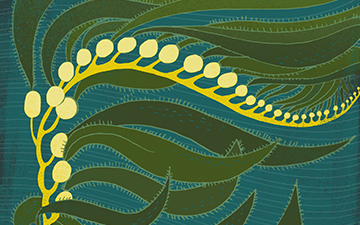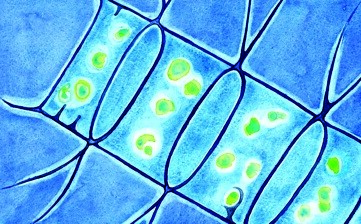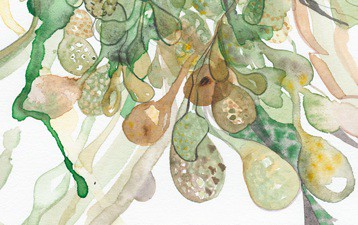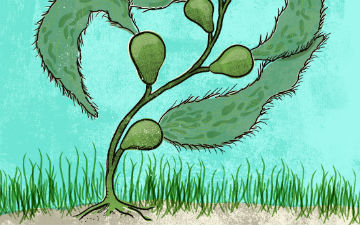Heterokontophyta

Giant Kelp
Macrocystis pyrifera



3 POINTS
Fact: Darwin is thought to be one of the first scientists to consider the ecological importance of kelp comparing them to an aquatic version of a forest of trees.
cool, warm
Graphic by Rachel Ignotofskywww.rachelignotofskydesign.com/
Photo by Claire Facklercommons.wikimedia.org/wiki/File:Sanc0063_-_Flickr_-_NOAA_Photo_Library.jpg
Macrocystis pyrifera, commonly known as giant kelp or giant bladder kelp, is a species of kelp (large brown algae), and one of four species in the genus Macrocystis. Giant kelp is common along the coast of the easternPacific Ocean, from Baja California north to southeast Alaska, and is also found in the southern oceans nearSouth […] read more

Phytoplankton
Diatom Order


Sorry, there is no photo available. If you have one, please submit
here
.
2 POINTS
Fact: Diatoms belong to a large group called the heterokonts, including both autotrophs and heterotrophs
cold, cool, warm
Graphic by Ernst Haeckel (1904)
Diatoms[5] are a major group of algae, and are among the most common types ofphytoplankton. Most diatoms are unicellular, although they can exist as colonies in the shape of filaments or ribbons (e.g. Fragilaria), fans (e.g. Meridion), zigzags (e.g. Tabellaria), or stars (e.g. Asterionella). Diatoms are producers within the food chain. A unique feature of […] read more

Diatom
Chaetocerus spp.


Sorry, there is no photo available. If you have one, please submit
here
.
3 POINTS
• Prochlorococcus spp. is a PLANKTON SPECIES.
cool, warm
Graphic by Melissa Guionwww.melissaguion.com
Chaetoceros is probably the largest genus of marine planktonic diatoms with approximately 400 species described. Although a large number of these descriptions are no longer valid. It is often very difficult to distinguish between different Chaetocerosspecies.[1] Several attempts have been made to restructure this large genus into subgenera and this work is still in progress[2][3]However, most of […] read more

Brown macroalgae
Sargassum spp.


Sorry, there is no photo available. If you have one, please submit
here
.
3 POINTS
• Sargassum spp. is an ALGAE and PLANKTON SPECIES.
cool, warm
Graphic by Emilie Clarkwww.emilieclark.com
Sargassum is a genus of brown (class Phaeophyceae) macroaldga (seaweed) in the order Fucales. Numerous species are distributed throughout the temperate and tropical oceans of the world, where they generally inhabit shallow water and coral reefs. However, the genus may be best known for its planktonic (free-floating) species. While most species within the class Phaeophyceae are predominantly cold […] read more

Giant Kelp
Macrocystis pyrifera


Sorry, there is no photo available. If you have one, please submit
here
.
3 POINTS
Fact: Macrocystis pyrifera is one of the fastest-growing organisms on Earth, growing more than 60 centimetres per day
cool, warm
Graphic by Lindsay Chetekwww.lindsaychetek.com/
Giant kelp Macrocystis pyrifera Scientific classification Kingdom: Chromalveolata Division: Heterokontophyta Class: Phaeophyceae Order: Laminariales Family: Laminariaceae Genus: Macrocystis Species: M. pyrifera Binomial name Macrocsytis pyrifera (L.) C.Ag.[1] Synonyms Fucus pyrifer L. Laminaria pyrifera (L.) Lamouroux M. humboldtii (Bonpland) C.Ag. M. planicaulis C. Agardh M. pyrifera var. humboldtii Bonplan. Macrocystis pyrifera, commonly known as Giant kelp […] read more

Phytoplankton
Class: Bacillariophyceae


Sorry, there is no photo available. If you have one, please submit
here
.
1 POINT
Play: Symbiodinium spp has a MOVE of 1, and is often eaten by KRILL SPECIES.
Fact: Symbiodinium spp are also crucially dependent on minerals
cold, cool, warm
Graphic by Kyu Hwangkyuhwang.com/
Phytoplankton (English pronunciation: /ˌfaɪtoʊˈplæŋktən/) are the autotrophic component of the plankton community. The name comes from the Greek words φυτόν (phyton), meaning “plant“, and πλαγκτός (planktos), meaning “wanderer” or “drifter”.[1] Most phytoplankton are too small to be individually seen with the unaided eye. However, when present in high enough numbers, they may appear as a […] read more